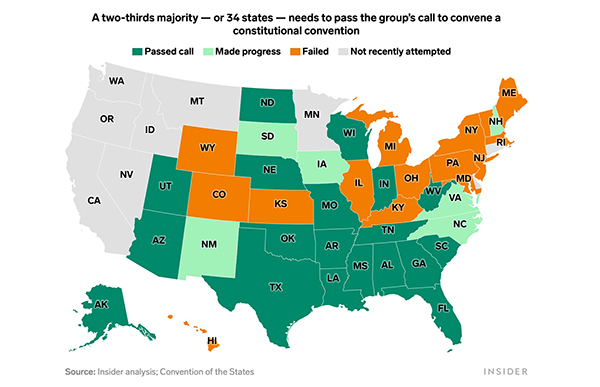

Art. V of the Constitution offers two ways to amend the document. First, anyone in Congress can propose an amendment. This has been done over 11,000 times. If two-thirds of each chamber support it, it goes to the states for ratification. To be added to the Constitution, three-quarters of the states (i.e., 38 states) have to ratify it. That has become hugely difficult, with the only one amendment ratified in the past 50 years, the 27th Amendment in 1992. It's only one sentence, but you get an A+ if you know what it is about.
The other way to amend the Constitution is to call Constitutional Convention. This requires two-thirds of the states (34) to ask to Congress for one. Currently, Republicans control 28 state legislatures, which is within spitting distance of 34. Many conservatives want to call such a Convention and completely rewrite the Constitution there. Among other clauses would be:
And a whole laundry list of other things. Some current Amendments might get repealed. Top targets are the 1st (prohibits Congress from establishing an official religion), 13th (no slavery), the 14th (due process), 16th (income tax), 17th (direct election of senators), and 19th (women's suffrage). Maybe go whole hog while they are at it and have a new one stating that any state wishing to restrict voting to straight white Christian men over 30 who own property (real estate) would be constitutional. The sky's the limit here. However, note that a Convention could only propose amendments. They would still have to be ratified by 38 states.
How close are we to 34? Here is a map showing the current status. The map linked to has a pop-up box for each state showing the status of the call in that state.

Nineteen states have passed a call and six more are working on it. It failed in 15 states, but several of them (Wyoming, Kansas, Ohio, and Kentucky) are Republican-controlled and could try again. Idaho and Montana didn't try, but it could probably pass there. Getting to 34 could be touch-and-go. It would be close.
The U.S. has come close to a Convention a few times. After the Supreme Court required "one person, one vote," which made all legislative districts have the same population, 32 states signed on. In 1969, Iowa became #33, but no state signed up to be #34, which would have triggered the process. Less than a decade later, it happened again, this time over a balanced-budget amendment. This one got 32 states to apply. Of course, once the Convention started, the delegates could just rewrite the Constitution from scratch.
Part of the problem with a convention is that the Constitution doesn't define the rules for it. Would each state get one delegate and one vote or would each state get as many delegates as it has members of Congress (like the electoral college)? Things like that kind of matter. Who picks the delegates? The state legislature? Can the governor veto the choices? Election by congressional district (plus two statewide) or all statewide (like presidential electors)? Under what rules would the convention operate? Could Congress make them? Could the convention throw out these rules? It could be a real mess. Let's be honest, sometimes the Founding Parents did sloppy work.
There is a group actively working to invoke such an Article V convention. In 2016, a group of over 100 state legislators gathered in Williamsburg, VA, to run a mock convention, to get their plans debugged. They even made a video about it:
The video is extremely slick and believable. It was clearly made by very serious professionals. It even has cameo appearances by James Madison and George Washington. The whole thing is done the way the national media cover the Democratic and Republican Conventions, with clips of people making motions, debates, reporters discussing the action, and more. It runs for almost 6 hours, but if you watch the first half an hour, you get a pretty clear idea that these folks are deadly serious. And remember, the attendees are mostly actual state representatives and state senators, not random actors hired for the video.
In principle, blue states could also work on plans for one, too, but there are only 17 Democratic trifectas, so they would need to corral another 17 like-minded states. That is very unlikely under the current map. (V)